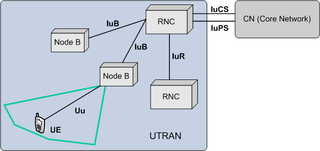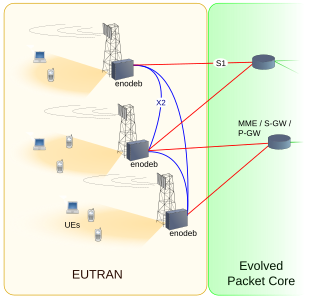RBS6000 can be used for GSM (GERAN) with DUG cards, UMTS (UTRAN) with DUW cards, and LTE (eUTRAN) with DUL/DUS cards.
The RBS site can be interconnected to the rest of the RAN with a SIU card (Site Integration Unit) which use either electrical, microwave or optical backhaul to the rest of the RAN and also provides Abis over IP connectivity for GSM base station.
RBS runs the embedded Operating System OSE from Enea from Sweden.
RBS hardware cards
The RBS6000 cabinet usually uses these cards to achieve function:
- DXB Distribution Switch Board,
- DXU Distribution Switch Unit,
- IXU Interface and Switching Unit
- DUG cards for GSM (GERAN) aka "Digital Unit GSM"
- DUW cards for UMTS (UTRAN)
- DUL Digital Unit cards for LTE (eUTRAN)
- DUS Digital Unit cards for combined GSM, UMTS and LTE service
- ECU Energy Control Unit,
- RUG Radio Unit GSM,
- RUS Radio Unit all Standards,
- RRUS Remote Radio Unit all Standards,
- TCB Transceiver Control Board
- BDM Battery Distribution Module
- BFU Battery Fuse Unit
- CDU Combining and Distribution Unit,
- CXU Configuration Switch Unit,
- FCU Fan Control Unit,
- PDU Power Distribution Unit,
- PSU Power Supply Unit,
- RXU Receiver Unit,
- SAU Support Alarm Unit,
- SCU Support Control Unit,
- TMA_CM, TXU Transmitter Unit
RBS Operations and Maintenance
The RBS is managed locally thanks to Ericsson software named "OMT" (Operations and Maintenance Terminal). OMT is what is usually called a LMT (Local Maintenance Terminal). A special cable is needed to connect to the serial port of the RBS with the LMT. This cable has the following simplistic pinout:
2 (DB9) ---> 3 (RJ45) 3 (DB9) ---> 2 (RJ45) 5 (DB9) ---> 1 (RJ45)
The more complete and official cable (and more complicated) has the following pinout:
5 (DB9) ---> 1 (RJ45) 3 (DB9) ---> 2 (RJ45) 2 (DB9) ---> 3 (RJ45) 8 (DB9) ---> 4 (RJ45) 7 (DB9) ---> 5 (RJ45) 4 (DB9) ---> 6+8 (RJ45) 6+1 (DB9) ---> 7 (RJ45)

Telefonaktiebolaget LM Ericsson, commonly known as Ericsson, is a Swedish multinational networking and telecommunications company headquartered in Stockholm. The company sells infrastructure, software, and services in information and communications technology for telecommunications service providers and enterprises, including, among others, 3G, 4G, and 5G equipment, and Internet Protocol (IP) and optical transport systems. The company employs around 100,000 people and operates in more than 180 countries. Ericsson has over 57,000 granted patents.

Enhanced Data rates for GSM Evolution (EDGE) also known as Enhanced GPRS (EGPRS), IMT Single Carrier (IMT-SC), or Enhanced Data rates for Global Evolution) is a digital mobile phone technology that allows improved data transmission rates as a backward-compatible extension of GSM. EDGE is considered a pre-3G radio technology and is part of ITU's 3G definition. EDGE was deployed on GSM networks beginning in 2003 – initially by Cingular in the United States.

The Global System for Mobile Communications (GSM) is a standard developed by the European Telecommunications Standards Institute (ETSI) to describe the protocols for second-generation (2G) digital cellular networks used by mobile devices such as mobile phones and tablets. It was first deployed in Finland in December 1991. By the mid-2010s, it became a global standard for mobile communications achieving over 90% market share, and operating in over 193 countries and territories.

General Packet Radio Service (GPRS) is a packet oriented mobile data standard on the 2G and 3G cellular communication network's global system for mobile communications (GSM). GPRS was established by European Telecommunications Standards Institute (ETSI) in response to the earlier CDPD and i-mode packet-switched cellular technologies. It is now maintained by the 3rd Generation Partnership Project (3GPP).
The Universal Mobile Telecommunications System (UMTS) is a third generation mobile cellular system for networks based on the GSM standard. Developed and maintained by the 3GPP, UMTS is a component of the International Telecommunication Union IMT-2000 standard set and compares with the CDMA2000 standard set for networks based on the competing cdmaOne technology. UMTS uses wideband code-division multiple access (W-CDMA) radio access technology to offer greater spectral efficiency and bandwidth to mobile network operators.
The 3rd Generation Partnership Project (3GPP) is an umbrella term for a number of standards organizations which develop protocols for mobile telecommunications. Its best known work is the development and maintenance of:
The GPRS core network is the central part of the general packet radio service (GPRS) which allows 2G, 3G and WCDMA mobile networks to transmit IP packets to external networks such as the Internet. The GPRS system is an integrated part of the GSM network switching subsystem.
Mobility management is one of the major functions of a GSM or a UMTS network that allows mobile phones to work. The aim of mobility management is to track where the subscribers are, allowing calls, SMS and other mobile phone services to be delivered to them.

The base station subsystem (BSS) is the section of a traditional cellular telephone network which is responsible for handling traffic and signaling between a mobile phone and the network switching subsystem. The BSS carries out transcoding of speech channels, allocation of radio channels to mobile phones, paging, transmission and reception over the air interface and many other tasks related to the radio network.

A cellular network or mobile network is a communication network where the link to and from end nodes is wireless. The network is distributed over land areas called "cells", each served by at least one fixed-location transceiver. These base stations provide the cell with the network coverage which can be used for transmission of voice, data, and other types of content. A cell typically uses a different set of frequencies from neighboring cells, to avoid interference and provide guaranteed service quality within each cell.

UTRAN is a collective term for the network and equipment that connects mobile handsets to the public telephone network or the Internet. It contains the base stations, which are called Node B's and Radio Network Controllers (RNCs) which make up the UMTS radio access network. This communications network, commonly referred to as 3G, can carry many traffic types from real-time Circuit Switched to IP based Packet Switched. The UTRAN allows connectivity between the UE and the core network.
Multimedia Broadcast Multicast Services (MBMS) is a point-to-multipoint interface specification for existing 3GPP cellular networks, which is designed to provide efficient delivery of broadcast and multicast services, both within a cell as well as within the core network. For broadcast transmission across multiple cells, it defines transmission via single-frequency network configurations. The specification is referred to as Evolved Multimedia Broadcast Multicast Services (eMBMS) when transmissions are delivered through an LTE network. eMBMS is also known as LTE Broadcast.
A radio access network (RAN) is part of a mobile telecommunication system. It implements a radio access technology. Conceptually, it resides between a device such as a mobile phone, a computer, or any remotely controlled machine and provides connection with its core network (CN). Depending on the standard, mobile phones and other wireless connected devices are varyingly known as user equipment (UE), terminal equipment, mobile station (MS), etc. RAN functionality is typically provided by a silicon chip residing in both the core network as well as the user equipment. See the following diagram:
CN / ⧵ / ⧵ RAN RAN / ⧵ / ⧵ UE UE UE UE

E-UTRA is the air interface of 3rd Generation Partnership Project (3GPP) Long Term Evolution (LTE) upgrade path for mobile networks. It is an acronym for Evolved Universal Mobile Telecommunications System (UMTS) Terrestrial Radio Access, also referred to as the 3GPP work item on the Long Term Evolution (LTE) also known as the Evolved Universal Terrestrial Radio Access (E-UTRA) in early drafts of the 3GPP LTE specification. E-UTRAN is the initialism of Evolved UMTS Terrestrial Radio Access Network and is the combination of E-UTRA, user equipment (UE), and E-UTRAN Node B or Evolved Node B (eNodeB).

In telecommunications, Long-Term Evolution (LTE) is a standard for wireless broadband communication for mobile devices and data terminals, based on the GSM/EDGE and UMTS/HSPA standards. It improves on those standards' capacity and speed by using a different radio interface and core network improvements. LTE is the upgrade path for carriers with both GSM/UMTS networks and CDMA2000 networks. Because LTE frequencies and bands differ from country to country, only multi-band phones can use LTE in all countries where it is supported.
The Mobile Telephone Switching Office (MTSO) is the mobile equivalent of a PSTN Central Office. The MTSO contains the switching equipment or Mobile Switching Center (MSC) for routing mobile phone calls. It also contains the equipment for controlling the cell sites that are connected to the MSC.
A GSM Cell ID (CID) is a generally unique number used to identify each base transceiver station (BTS) or sector of a BTS within a location area code (LAC) if not within a GSM network.

A remote radio head (RRH), also called a remote radio unit (RRU) in wireless networks, is a remote radio transceiver that connects to an operator radio control panel via electrical or wireless interface. When used to describe aircraft radio cockpit radio systems, the control panel is often called the radio head.
Huawei SingleRAN is a radio access network (RAN) technology offered by Huawei that allows mobile telecommunications operators to support multiple mobile communications standards and wireless telephone services on a single network. The technology incorporates a software-defined radio device, and is designed with a consolidated set of hardware components, allowing operators to purchase, operate and maintain a single telecommunications network and set of equipment, while supporting multiple mobile communications standards.
E-UTRAN Node B, also known as Evolved Node B, is the element in E-UTRA of LTE that is the evolution of the element Node B in UTRA of UMTS. It is the hardware that is connected to the mobile phone network that communicates directly wirelessly with mobile handsets (UEs), like a base transceiver station (BTS) in GSM networks.









